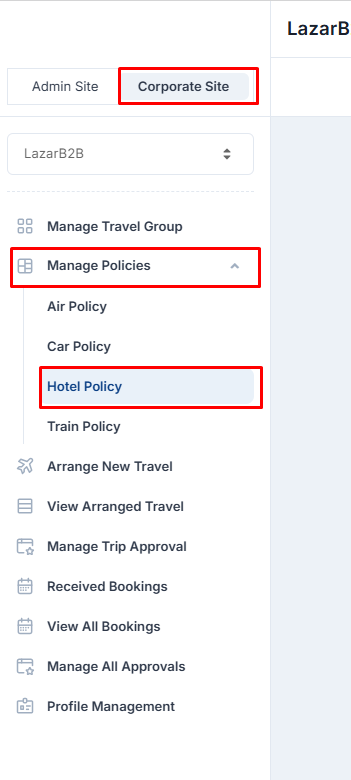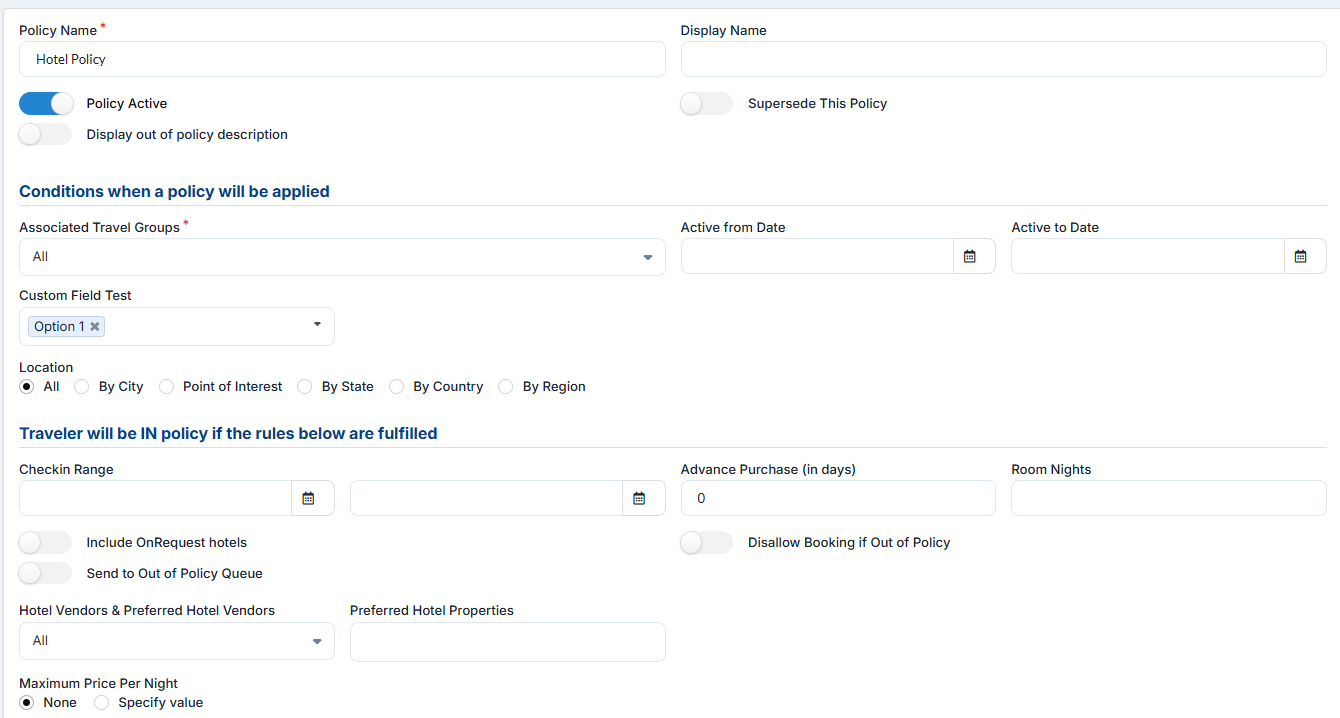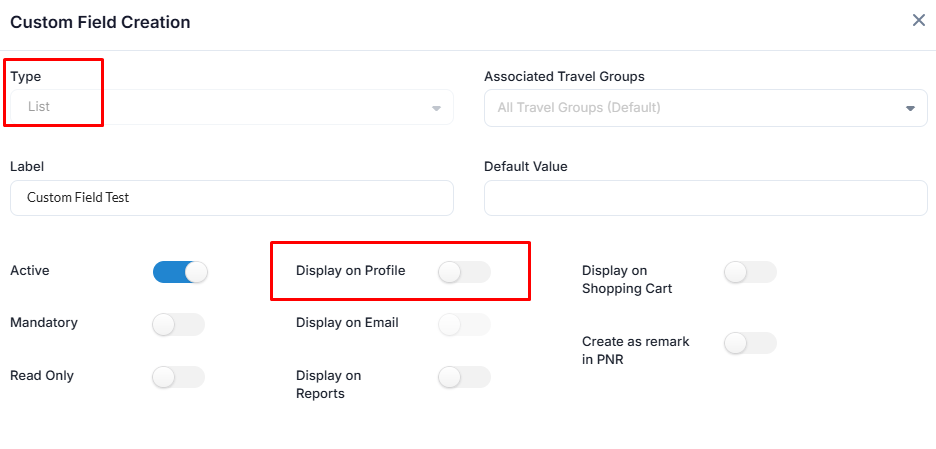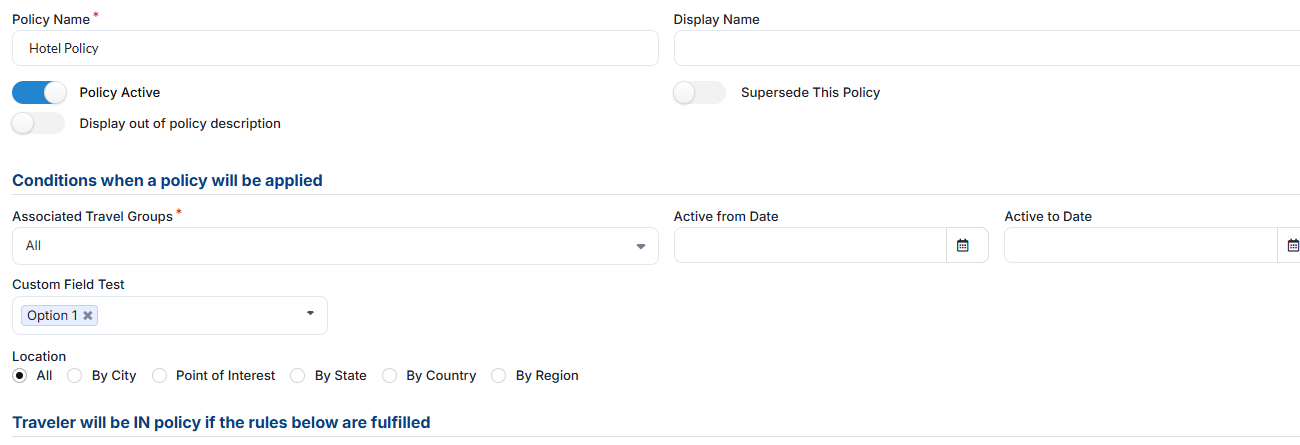TABLE OF CONTENTS
- Introduction
- Hotel Travel Policies
- Hotel Policy Custom Fields
- Application of the Most Restrictive Policy
Introduction
In order to locate Hotel Travel Policy Settings use the following path:
Corporate Site → Manage Policies → Hotel Policy

Image 1. Travel Policies Location
Corporate travel policies are typically developed by the Travel Group Administrators and specify things like whether an employee is permitted to rent a luxury car, how many weeks or business days in advance they should book their reservations, or if there are any additional limits when it comes to total sum that can be spent.
Note — By default, Thomalex system creates one default Hotel Travel Policy. This policy should ideally be modified right after the website has been created or deleted to create a brand new one from scratch.
Notice that each travel group can have multiple Air, Car, and Hotel Travel Policies enabled at the same time. Therefore it's important to pay attention to what policies are set to be "Active" simultaneously.
Finally, by a very basic principle, for each service on the Thomalex system you will know which search result is within the travel policy by being highlighted in green if its "In Policy" and by being highlighted in red if "Out of Policy", example:
 Image 2. Examples of "In policy" (green) and "Out of policy" (red)
Image 2. Examples of "In policy" (green) and "Out of policy" (red)
Hotel Travel Policies
Air, car, and hotel policies in the Thomalex corporate environment share the basic configuration and the available settings that can be set.
Creating a hotel travel policy for employees is necessary to help keep your employees following the corporation's rules and your business travel expenditure as low as possible.
By accessing the Hotel Policy, the Policy panel will appear, here we are able to see the existing and/or create new Policies.

Image 3. Hotel Policy Panel
Any setting with the red * next to its name is a mandatory setting and without it, a Policy can't be established.
After you have filled in all the necessary information and clicked on "Save" the newly created policy will appear in the "Hotel Policies List":

Image 4. Newly created policy
At any time the newly created policy can be updated with new settings or entirely deleted. Often times it's easier to just edit the Hotel Policy that is created by the system and proceed using the travel policy in that way but that's all up to the customer's preferences.
Once the policy is deleted it can't be restored. However, at any time you are able to toggle the policy between Active and Inactive status by checking the "Policy Active" option next to the "Policy Name" option at the very top of the Policy Creation panel:
Image 5. "Policy Active" Setting Location
That way it's going to be very handy to manage the status of numerous policies without deleting them.
Note that after making a Policy Active or Inactive it must be Updated for the changes to take place.
Now, In the following lines, we will explain each setting of Hotel Travel Policies in detail.
Setting Name | Description |
| Policy Name | Specify the name of the policy. Example: Any name that will be easy to distinguish between various hotel policies created. For instance - "Overseas visit" or "London crew stays". |
| Display Name | Type the name of the policy. Example: Any name that will easily differentiate between numerous policies. Such as "Upper Management Hotel Policy". |
| Policy Active | This option is necessary to be enabled if the Policy needs to be active. The Policy can be toggled on/off with this option without the need to delete it. |
| Supersede This Policy | The business logic is such that only one policy can be applicable at a given time, the most restrictive one. However, if you enable this option, the policy will overpower all other policies. |
| Display out of policy description | If this option is enabled, out of policies description will be displayed |
| Associated Travel Groups | Here, we can choose which of the Travel Groups this Policy will be enabled for or rather which Travel Groups will use this policy. |
| Active from Date - Active to Date | Define the time frame in which the policy will be active. Example: If set to be applied from January to December of the following year; the policy will have effect only within that time frame. Note that policy will not be activated prior to the set "Book from date" and will produce no effect after defining "Book to Date". |
| Location | Specify the departure and arrival locations to which this policy applies. The options are: All — For covering the whole world and all the possible booking locations. Example: If "All" is selected it will create a rule to be applicable to hotel bookings at any possible location. Point of Interest — Applies to the Points of Interest and uses the Radius around them to find the booking locations. Example: We chose the radius of 25 (depending on the settings in Hotel Travel Settings this option will be either 25km or 25 miles.). This will show us any booking in that radius around Niagara Falls
Image 6. Point of Interest Location Option By City — Applies to the selected city. Example: If "City" is selected then it will apply a rule to any hotel within the radius of the selected city. By State — Applies to the State. Example: If "State" is selected then it will apply a rule to any hotel within that State. By Country — Applies to any location within a specified country. After clicking this option, select the country from the list of all countries in the world. Example: If "Country" is selected it will apply to any hotel within the selected country. By Region — Applies to any location within a specified custom region. If you enable this option, select the region from the list of all regions defined for the Travel group and Travel groups above the Travel group in the Travel group hierarchy. Example: If "Custom Region" is enabled it will apply to any location within a specified custom region. |
| Check-in Range | Allows you to set the check-in range related to set dates that will be in policy. All other dates will result as "Out of policy". Example: If set between January and December of the following year — the hotel results within the mentioned year will be in policy, and all results for other dates will be returned as "Out of policy" |
| Advance Purchase (in days) | Allows you to define the number of days in advance for booking hotels that will be specified as days for "In policy" bookings, anything less than the set number of days will be considered as "Out of policy". Example: When "7" is set, all Hotels that are booked seven days from today will be in policy, and less than seven days will be out of policy. |
| Room Nights | Specify the max renal duration for which the hotel results will provide "In policy" results. Example: If you set "10" then all hotel searches that are for more than ten days of duration will be "Out of policy". |
| Hotel Vendors and Preferred Hotel Vendors | Optionally, specify hotel chains to which this policy applies. You are able to specify all hotel vendors or just a few. Use the tick on the left side of the list to select the vendor:  Image 7. Preferred Vendor Selection Image 7. Preferred Vendor SelectionThis tick will be considered for IN/OUT policy decision. Display rank per preferred vendor - Use the tick on the right-hand side of the list to select the vendor:  Image 8. Selecting level of preferences display Image 8. Selecting level of preferences display This tick will not make any difference in IN/OUT policy decision but will show the preference rank up to three beds once the hotel results with a set preference level are selected. |
| Preferred Hotel Properties | Enter Hotel Property codes |
| Maximum Price Per Night | Maximum Price Per Night is a fixed value set to limit the Price. This value can be specified only as a fixed value. Example: If we set the Maximum Price Per Night to $150, all of the Prices Per Night that are over $150 will be out of policy, while all of the Prices Per Night that are under $150 will be in policy. We recommend not to enable this option at the same time as Price Cap Per Night as their limitations will conflict with each other. |
| Price Cap Per Night | Price Cap Per Night will look for a cheapest Hotel Room Per Night and set the added Cap (Either in Maximum Percent or Maximum Amount). Example: If the cheapest Hotel Room we have available is $100, and the Price Cap Per Night is set to 10%, it will limit what we can book to $110 (Cheapest + Amount we set). We recommend not to enable this option at the same time as Maximum Price Per Night as their limitations will conflict with each other. |
| Hotel Vendors | Specify which hotel vendors will be considered to be "In policy". You are able to enter either hotel vendors' names or property codes. These property codes are set on the Amadeus' side. The property Code is formatted as: Chain Code + IATACode + HotelCode The amount of characters should be equal to 8. Example: If the hotel code or property name of "Marriott International" is set then all other hotel properties will be resulted as "Out of policy". |
| *Custom Fields | This option will appear only if the custom field that is created is created as a type list and if Display on Policy is activated. More about it can be found in the Custom Fields Document. |
Table 1. Hotel Policy Settings and Descriptions
Hotel Policy Custom Fields
Custom Fields can also be added to Policies themselves. They are used to check the information set on the Employee's Profile with the information set in the Policy itself.
To enable the Custom Fields in Policies, we need to set their Type to List and enable Display on Profile.

Image 9. Options to enable Custom Fields in Policy
After those options have been enabled, a new toggle button will be shown to us, and "Display on Policy" can now be seen.

Image 10. Display on Policy toggle location
Now, if we activate this option whichever Custom Field we create, will be shown in our Policy Tab.
For example, we have made a basic Custom Field to show the usage of it in Policy.

Image 11. Custom Field Options Example
If we choose "Option 1" in Policy, we would need to choose "Option 1" in the Employee's Profile too for their bookings to be in Policy.

Image 13. Custom Field Option Chosen in Policy
In the Employee's Profile we can find this Custom Field too, and if we choose the same "Option 1" all of the bookings (if they also fall under other rules of the Policy) will be in Policy.

Image 14. Custom Field Option Chosen in Employee's Profile
If any of these 2 Custom Fields does not match the other one, it will make the Flights out of Policy for the Employee.
If the Booking is being created for the "Guest" Traveler, this Custom Field rule will be taken from the Coordinator which created the Booking.
Application of the Most Restrictive Policy
Having more than one active policy is often the most used corporate model. Thomalex corporate environment allows you to have numerous active policies at the time.
The most restrictive policy will be the one that is going to be used as a reference for acknowledging if the search request is "In policy" or "Out of policy".
Following the mentioned set of preferences, the next level would be favoring the set location (country, state, city...).
On the other hand, if there's a case where there are two policies that both have the same trip reason, and both are set to have the appropriate location - the system will create further restriction references that will additionally establish restraint calculation.
The further restriction references would be the "Maximum Price" followed by the "Maximum Price Per Night" and followed by the "Maximum Number Of Nights".
It's important to understand that rule of the thumb is to follow the most restrictive attributes of the set policies. Whenever there is more than one active and applicable to the search request - the system will always favor the most restrictive one.

